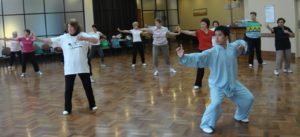Improve Adult Onset Diabetes with Qigong
By John M. de Castro, Ph.D.
“After 12 weeks, the qigong patients had lowered their fasting blood glucose and their levels of self-reported stress and improved their insulin resistance. The gentle exercise group also brought down blood glucose levels, though somewhat less…and lowered stress.” – BottomLine
Diabetes is a major health issue. It is estimated that 30 million people in the United States have diabetes and the numbers are growing. Type 2 Diabetes results from a resistance of tissues, especially fat tissues, to the ability of insulin to promote the uptake of glucose from the blood. As a result, blood sugar levels rise producing hyperglycemia. Diabetes is the 7th leading cause of death in the United States. In addition, diabetes is heavily associated with other diseases such as cardiovascular disease, heart attacks, stroke, blindness, kidney disease, and circulatory problems leading to amputations. As a result, diabetes doubles the risk of death of any cause compared to individuals of the same age without diabetes.
Type 2 diabetes is a common and increasingly prevalent illness that is largely preventable. One of the reasons for the increasing incidence of Type 2 Diabetes is its association with overweight and obesity which is becoming epidemic in the industrialized world. Qigong and Tai Chi have been practiced for thousands of years with benefits for health and longevity. Qigong and Tai Chi trainings are designed to enhance function and regulate the activities of the body through controlled breathing, mindful concentration, and gentle movements. Only recently though have the effects of these practices been scrutinized with empirical research. This research has found that they are effective for an array of physical and psychological issues.
Diet and exercise are prescribed to treat Type 2 Diabetes. Qigong and Tai Chi are gentle exercises that are potentially useful in treating Type 2 Diabetes. In today’s Research News article “The Effects of Qigong on Type 2 Diabetes Mellitus: A Systematic Review and Meta-Analysis.” (See summary below or view the full text of the study at: https://www.ncbi.nlm.nih.gov/pmc/articles/PMC5817377/ ), Meng and colleagues review, summarize, and perform a meta-analysis of the 21 published research studies regarding the effectiveness of Qigong practice in the treatment of Type 2 Diabetes.
The summary of the research indicates that Qigong practice improves fasting glucose levels in Type 2 Diabetes patients when compared to a no-exercise condition, but the improvement is not significantly different than that produced by other exercise programs. Importantly, Qigong practice was found to improve Glycosylated Hemoglobin (HbA1c) and two-hour postprandial (after eating) blood glucose levels both in comparison to no-exercise and other exercise groups. Hence, the published research suggests that Qigong practice is superior to other exercises in improving the symptoms of Type 2 Diabetes.
These are encouraging findings. Qigong practice appears to be an almost ideal exercise for adult-onset diabetes (Type 2). It not only produces better results than other exercises but it is also not strenuous, involving slow gentle movements, is safe, having no appreciable side effects, it is appropriate for all ages including the elderly and for individuals with illnesses that limit their activities or range of motion, is inexpensive to administer, can be performed in groups or alone, at home or in a facility or even public park, and can be quickly learned. In addition, it can be practiced in social groups without professional supervision. This can make it fun, improving the likelihood of long-term engagement in the practice.
So, improve adult onset diabetes with Qigong.
“Many people, however, are unable to keep up with their regular exercise because they either don’t enjoy it, or have a problem finding time to exercise. Tai chi offers a major advantage: It’s enjoyable, and to many, it’s almost addictive. . . . You can practice Tai Chi almost anywhere. Stress stands in the way of controlling diabetes. Since tai chi encourages mental relaxation and reduces stress, it follows that Tai Chi can improve the control of diabetes.” – Paul Lam
CMCS – Center for Mindfulness and Contemplative Studies
This and other Contemplative Studies posts are also available on Google+ https://plus.google.com/106784388191201299496/posts and on Twitter @MindfulResearch
Study Summary
Meng, D., Chunyan, W., Xiaosheng, D., & Xiangren, Y. (2018). The Effects of Qigong on Type 2 Diabetes Mellitus: A Systematic Review and Meta-Analysis. Evidence-Based Complementary and Alternative Medicine : eCAM, 2018, 8182938. http://doi.org/10.1155/2018/8182938
Abstract
Objective
The purpose of this study was to investigate the effects of Qigong on type 2 diabetes mellitus (DM) using the systematic review and meta-analysis.
Methods
All prospective, randomized, controlled clinical trials published in English or Chinese and involving the use of Qigong by patients with DM were searched in 7 electronic databases from their respective inception to June 2016. The meta-analysis was conducted using the Revman 5.2. The quality of the included trials was assessed using the Jadad rating scale. Two researchers independently completed the inclusion, data extraction, and quality assessment.
Results
Twenty-one trials with 1326 patients met the inclusion criteria and were reviewed. The meta-analysis demonstrated that, compared with no exercise, the Qigong had significant effects on fasting blood glucose (MD = −0.99, 95% CI (−1.23, 0.75), P < 0.0001), HbA1c (MD = −0.84, 95% CI (−1.02, −0.65), P < 0.0001), and postprandial blood glucose (MD = −1.55, 95% CI (−2.19, −0.91), P < 0.00001).
Conclusion
The Qigong training can improve the blood glucose status of the type 2 DM patients and has positive effects on the management of type 2 DM. However, future research with better quality still needs to be conducted to address the effects of Qigong on type 2 DM.
https://www.ncbi.nlm.nih.gov/pmc/articles/PMC5817377/


